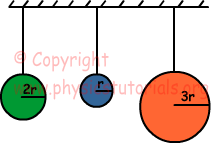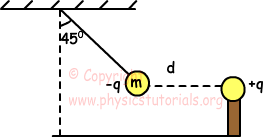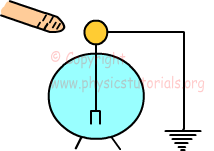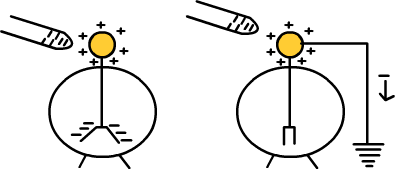Electrostatics Exam 3 and Problem Solutions
1. If we first touch A to B then A to C, find the final charges of these spheres. (charges of spheres;
1st sphere:8q, 2nd sphere:-2q, 3rd sphere:-14q)
 qA+qB=8q-2q=6q
qA+qB=8q-2q=6q
Charge per unit radius;
qr=qtotal/rtotal=6q/(2r+r)=2q/r
Charge of qA’=2r.2q/r=4q
Charge of qB=r.2q/2=2q
qtotal=qA’+qC=4q-14q=-10q
qr=qtotal/rtotal=-10q/(3r+2r)=-2q/r
Final charges of spheres:
qAfinal=2r.(-2q)/r=-4q
qCfinal=3r.(-2q)/r=-6q
qB=r.2q/2=2q
2. Look at the picture given below. Find the tension in the rope.
 Free body diagram of the system is given below;
Free body diagram of the system is given below;
 tan45⁰=F/mg=1
tan45⁰=F/mg=1
F=mg
k.q.q/d²=m.g
q=d√mg/k
We find T using pythagorean theorem
T²=F²+mg²
T²=(mg)²+(mg)²
T=mg√2
3. A, B and C spheres are charged. If A repels B and attracts C, and B is positively charged, find the types of charges of each sphere.
 If A repels B, then they must be charged with same charge; and if A attracts C then they must be charged with opposite charges.
If A repels B, then they must be charged with same charge; and if A attracts C then they must be charged with opposite charges.
4. We put negatively charged rod closer to neutral electroscope. If we ground electroscope, what will be the motion of the leaves of electroscope?
 When we put negatively charged rod near the sphere of electroscope, sphere is positively charged by induction and negative charges are repelled to the leaves. When we ground electroscope, negative charges move to the ground and leaves becomes neutral and closed.
When we put negatively charged rod near the sphere of electroscope, sphere is positively charged by induction and negative charges are repelled to the leaves. When we ground electroscope, negative charges move to the ground and leaves becomes neutral and closed.
 5. Find charge of q₃ to make total force acting on q₂ zero.
5. Find charge of q₃ to make total force acting on q₂ zero.
 F₁₂ must be equal F₂₃
F₁₂ must be equal F₂₃
k.q₁.q₂/d²=k.q₂.q₃/(2d)²
q₁/d²=q₃/4d²
q₃=4q1=4q